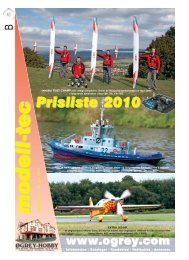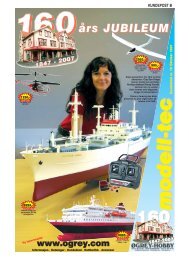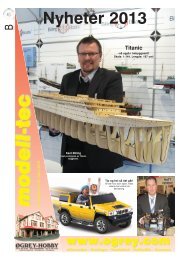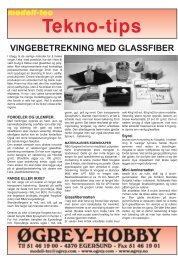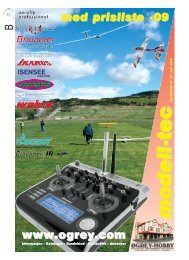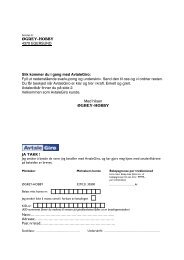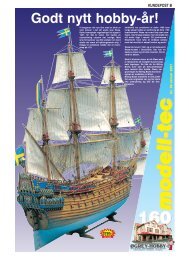Dual REcEivER Micro
Dual REcEivER Micro
Dual REcEivER Micro
- No tags were found...
You also want an ePaper? Increase the reach of your titles
YUMPU automatically turns print PDFs into web optimized ePapers that Google loves.
<strong>Dual</strong> <strong>REcEivER</strong> micro3.3 Routine checksPrior to every flight do the following routine checks:• First switch on transmitter then receiver.• Check that you have chosen the correct model in your transmitter.• Check that all control surfaces are working and that they are working in the right direction.• Check that all batteries are adequately charged.• Check that you have a micro SD-card inserted into the transmitter module for logging the data for the flight. For more info refer to chapter 5.• Check that all mixer functions are working correctly.• With transmitter and receiver both turned on, both of the green status lights (transmitter module and receiver) have to be on continuously.The transmitter module red light (in the middle) should not be illuminated at all.• For further functions of the lights on the transmitter module, see chapter 9.• Prior to starting the engine of a model, the model has to be restrained by either another person or a staring fixture.Make sure that no other person is within a range of 10 feet of the engine. For Turbine starts make sure that no person or other objectsare within 15 feet behind the exhaust area.Especially with electronic powered aircraft, make sure that the throttle is set to idle / off on the transmitter before turning on the receiver.This will avoid accidental start up of the propeller / rotor.3.4 installation in the modelThe correct installation of the receiver, the batteries, the servos as well as the routing of the cables and antennas are essential for the safe operation ofthe RC-system. weatronic 2.4 <strong>Dual</strong> FHSS <strong>Dual</strong> Receivers have been tested under conditions of extreme vibrations and extreme heat. None the less thesystem has to be protected from vibrations caused by the motor or from heat caused by exhaust systems or sun. Do not install the receiver in directvicinity of the exhaust system. It is best to mount the receiver to a surface with the help of strips of heavy foam and to allow air to circulate aroundit. Do not wrap the receiver into foam or other materials.3.5 antenna installationEach circuit of the <strong>Dual</strong> Receiver 2.4 <strong>Dual</strong> FHSS micro receivers is fed by a shielded antenna of 8 inch length. The effective antenna length though isonly the last 29 mm that are exposed at the end. The ends should be routed as far apart as possible and be angle at 90 degrees to each other.Exception: Carbon fuselages or fuselages with high carbon content. In these cases the antennas should be exposed outside of the fuselage.Carbon fiber has a strong shielding effect and will greatly reduce the range of the system extremely. The same counts for fuselages that havea metallic paint, a metal surface or are covered with a metal foil.4 Radio link descriptionThe weatronic 2.4 <strong>Dual</strong> FHSS RC-system is a proprietary development of the weatronic Company. The transmission of the signals is performed in themicro wave range in the 2.4 GHz-ISM-Band. For users who do not intend to acquire an individual license for every system, rules have been established.These rules have been established by the ETSI (European Telecommunications Standards Institute) and the US FCC. These rules were established tocreate telecommunication standards for all manufacturers and users.For being able to utilize the maximum allowed transmission power of 100mW EIRP, the rules in Europe mandate the use of the so called FHSS.(Frequency Hopping Spread Spectrum) weatronic uses 80 distinct frequencies with a channel width of 1 KHz each. Transmitter and receiver arehopping on these 80 channels at a rate of 100 jumps / second in a pseudo-random sequence. The algorithm (succession order of channels visited) isknown only to the transmitter and the bound receiver. Disturbed channels are being avoided until available again. This is called an.<strong>Dual</strong> FHSS in this context has three characteristics:• The transmitter works with a transceiver module and receives with both antennas• The receiver has two complete receiver units with their own individual antenna.• In addition to the transmission from the transmitter to the receiver- a return signal gets sent back from the receiver to the transmitter. (truelive feedback)The transmitter antennas are so called polar (surface)antennas, as they are being used in GPS systems or cell phones. They have a big advantage.Because of their circular polarization, the characteristic transmission pattern is close to being ideal. They are far superior to the commonly used linearpolarized W-LAN rod antennas.Circular polarized antennas create a more stable link, if obstacles intrude into the path of the link. Obstacles absorb some of the signals dependingon the materials in different polarization planes, so that signals from polarized antennas are less likely to be absorbed and with that provide a saferlink.



